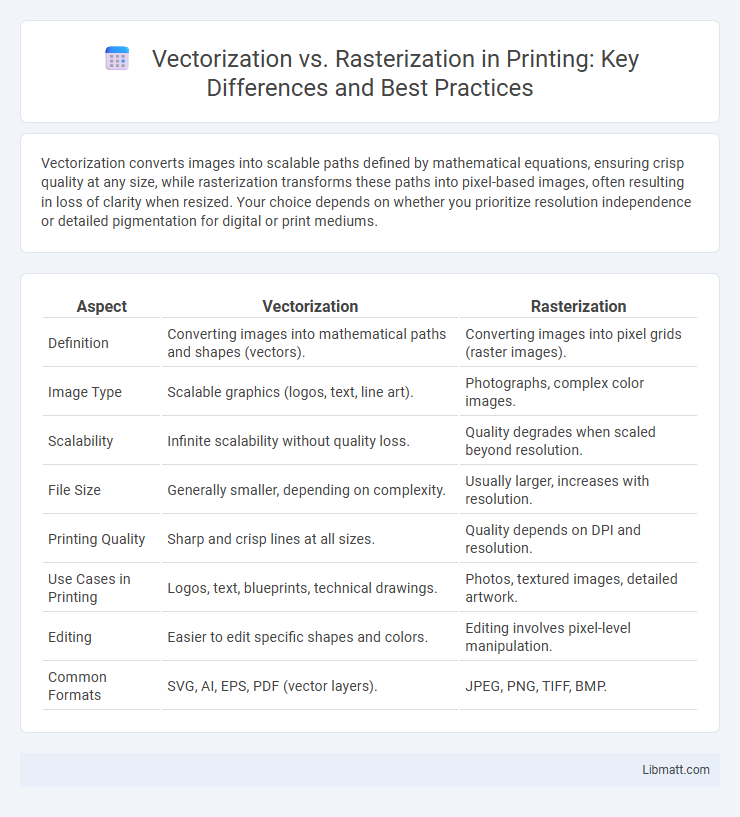Vectorization converts images into scalable paths defined by mathematical equations, ensuring crisp quality at any size, while rasterization transforms these paths into pixel-based images, often resulting in loss of clarity when resized. Your choice depends on whether you prioritize resolution independence or detailed pigmentation for digital or print mediums.
Table of Comparison
| Aspect | Vectorization | Rasterization |
|---|---|---|
| Definition | Converting images into mathematical paths and shapes (vectors). | Converting images into pixel grids (raster images). |
| Image Type | Scalable graphics (logos, text, line art). | Photographs, complex color images. |
| Scalability | Infinite scalability without quality loss. | Quality degrades when scaled beyond resolution. |
| File Size | Generally smaller, depending on complexity. | Usually larger, increases with resolution. |
| Printing Quality | Sharp and crisp lines at all sizes. | Quality depends on DPI and resolution. |
| Use Cases in Printing | Logos, text, blueprints, technical drawings. | Photos, textured images, detailed artwork. |
| Editing | Easier to edit specific shapes and colors. | Editing involves pixel-level manipulation. |
| Common Formats | SVG, AI, EPS, PDF (vector layers). | JPEG, PNG, TIFF, BMP. |
Understanding Vectorization and Rasterization
Vectorization converts raster images composed of pixels into scalable vector graphics defined by paths, curves, and points, enabling infinite resolution without loss of quality. Rasterization transforms vector graphics into pixel-based images for display or printing, determining pixel color by sampling vector shapes. Understanding these processes is crucial for optimizing image quality and file size across digital and print media.
Core Principles of Vector Graphics
Core principles of vector graphics involve using mathematical equations and geometric primitives like points, lines, and curves to create images, ensuring scalability without loss of quality. Your designs remain resolution-independent, enabling crisp visuals on any screen size or print medium. Vector graphics are ideal for logos, icons, and illustrations requiring precision and flexibility.
Key Features of Raster Graphics
Raster graphics consist of a grid of individual pixels, each storing color and brightness information, enabling detailed and complex images with smooth gradients and rich textures. The key features include fixed resolution, which can cause pixelation when scaled up, and high compatibility with photographic images, making them ideal for editing and manipulation in software like Adobe Photoshop. Your choice between rasterization and vectorization depends on whether you need scalable graphics or detailed image representation.
Comparing Image Quality and Scalability
Vectorization produces images using mathematical equations, resulting in sharp, scalable graphics that maintain quality at any size or resolution. Rasterization converts images into pixels, causing quality loss and pixelation when scaled beyond the original resolution. For high-quality, scalable visuals, vector graphics outperform raster images, especially in printing and digital displays.
File Size and Storage Considerations
Vectorization produces images through mathematical equations, resulting in significantly smaller file sizes and efficient storage compared to rasterization, which stores pixel-by-pixel details and tends to create larger files. Your choice between vector and raster formats impacts storage space, especially when working with high-resolution images, as vectors scale without increasing file size. For projects requiring minimal storage and scalability, vector files are more optimal than raster files, which can become bulky and demand more memory.
Performance in Different Applications
Vectorization offers superior performance in applications requiring scalability and precision, such as graphic design and CAD software, due to its mathematical representation of images. Rasterization excels in rendering complex scenes and detailed textures in real-time applications like video games and photo editing, leveraging pixel-based data for faster processing. Your choice between vectorization and rasterization depends on the need for resolution independence versus detailed texture handling.
Editing Flexibility: Vector vs Raster
Vector graphics offer superior editing flexibility because they are composed of scalable paths and points, allowing for easy resizing, reshaping, and color changes without loss of quality. Raster images, made of pixels, lose clarity when scaled or heavily edited, making detailed adjustments more challenging and often resulting in pixelation. Your choice depends on whether you need precision and scalability (vector) or rich detail and complex color gradations (raster).
Compatibility with Modern Design Tools
Vectorization seamlessly integrates with modern design tools like Adobe Illustrator and Sketch, allowing scalable and editable graphics that maintain quality across various devices. Rasterization, used in programs such as Adobe Photoshop, is ideal for detailed images but can suffer from pixelation when resized. Your choice depends on the need for flexibility and resolution in your design projects.
Typical Use Cases for Each Method
Vectorization excels in graphic design, logo creation, and scalable illustrations where precision and resolution independence are crucial. Rasterization is essential for photo editing, digital painting, and web images where detailed color variations and pixel-level manipulation are required. CAD software and GIS applications often employ vectorization for accurate spatial representation, while gaming and video processing rely heavily on rasterization for rendering complex scenes.
Choosing the Right Approach for Your Project
Vectorization involves converting images into scalable paths ideal for logos, icons, and designs requiring crisp resolution at any size, while rasterization renders images as pixel grids suited for complex color transitions and detailed photographs. Your project's nature--whether it demands scalability without quality loss or intricate color manipulation--determines the optimal method. Selecting vector graphics ensures flexibility and smaller file sizes for graphic design, whereas raster images excel in photo-realistic detail and texture.
vectorization vs rasterization Infographic

 libmatt.com
libmatt.com